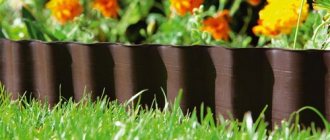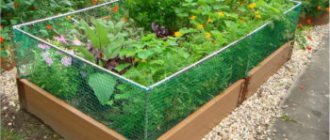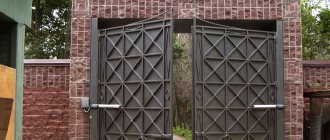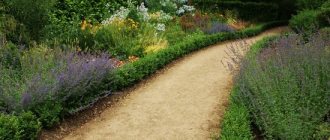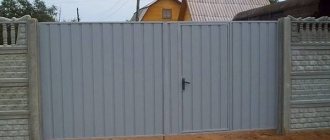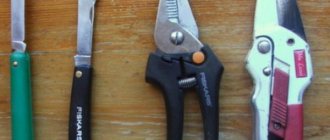Published: 04/19/2019 Category: Materials and technologies Views: 355
Types of sidewalk curbs
Various types of borders are used for landscaping adjacent areas, gardens and summer cottages. They serve not only an aesthetic function. With their help:
- separate pedestrian, roadway or garden areas;
- form flower beds, slides, garden paths and alleys;
- direct flows of rainwater to storm drains and thereby ensure the safety of the roadway.
Plastic borders
A simple solution for almost all vegetable gardens. Plastic fencing is available in different versions to suit any design. There are both discreet elements and bright, eye-catching sections.
There are the following types of plastic borders:
- Flexible tape - this fence is rolled into a roll, it is rolled out to the required length and given the required shape, such a fence can follow all the curves of the path. The tape is buried in the ground 23 times its width, so it is almost invisible on the site, but it copes with the tasks assigned to it.

Plastic borders can have any shape and design Source cdn.decoratorist.com
- Sectional borders for paths consist of a set of elements that are interconnected to form a decorative fence. Each section is attached to the other using special locks, which simplifies and speeds up installation.
- Imitations - plastic is made in the form of other materials: stone, tiles, wood, brick, etc. The fence can also be assembled in a matter of minutes.
Plastic sidewalk curb
It is used mainly for decorating garden areas in summer cottages and has the following advantages:
- low cost;
- ease of installation;
- large selection of products;
- easy to replace;
- aesthetics.
Since plastic is light in weight and can be processed, it can be used to build a border of almost any shape - from straight to winding. If we consider a plastic border as a repairable material, then individual sections of the fence can be easily replaced in case of damage, which cannot be said about stone borders.
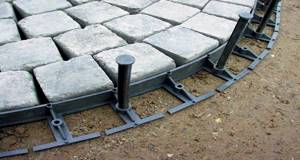
An example of using a plastic sidewalk curb.
The disadvantages include the following:
- poor fire resistance;
- low resistance to weathering;
- instability to mechanical damage.
Over time, a plastic border, unlike a stone one, will fade in the sun and crack from sudden temperature changes, which will shorten the service life of the product.
Installing a plastic border
If we compare the installation of plastic fences with concrete ones, the former win due to their simplicity. Installing a plastic curb is more convenient, and its light weight makes it quick and easy.
- A trench is dug along the sidewalk path. The depth of the groove should be up to 10 cm.
- Pegs located at the base of the plastic fence are driven into the trench.
- The individual elements of the border are connected to each other “in a lock”, forming a continuous row.
- The fence is leveled using a building level, and the trench is backfilled.
The peculiarity of installing a plastic border is that no preliminary preparation of the construction site is required. Such fences will be good when framing flower beds in garden plots.
Advantages and disadvantages of using plastic
Artificial fences are good because:
- Available in different colors and can be of almost any shape and size;
- service life is several years;
- installation does not require special skills or knowledge, all work can be done independently;
- require minimal or no care at all;
- resistant to temperature changes, high humidity, chemicals, and other aggressive substances;
- The product is available in any price category, so choosing something that fits your wallet will not be difficult.
Plastic borders have few disadvantages. The main one is the artificial origin of the material. However, the fences are safe for humans and plants. Plastic is also less strong and durable than stone, brick, concrete or metal. Due to its instability to impacts, it is not recommended to use plastic when lining gravel paths.
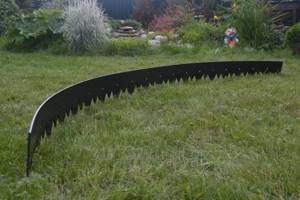
No special skills are required to install the tape Source ru.all.biz
See also: Catalog of companies that specialize in landscaping work on sites.
Advantages and disadvantages of plastic borders
Despite the fact that plastic fencing appeared much later than the usual ones, they managed to become widespread due to many advantages, which include:
- Durability . Curbs are made from wear-resistant plastics.
- Budget cost . The products are characterized by a low price compared to traditional fences made of stone and concrete. They do not require a sand bed or drainage system.
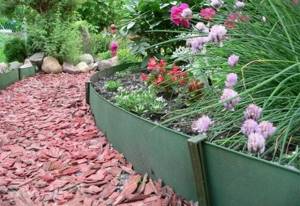
Effective separator Source doms.by
- Versatility . Plastic sidewalk borders are used to fence any elements of a personal plot (taking into account design features).
- Presentable appearance . You can choose a border to suit any landscape style: most products are available in several colors.
- Wide selection of models . You can use a decorative option or choose an inconspicuous, buried border.
- Wide possibilities . Borders are suitable for edging not only paths, but also other garden objects of any geometric shape.
- Thoughtful design . The curb elements are equipped with reliable, high-strength fasteners.
- Easy transportation and installation . To install most models, you will not need to carry out any preparatory work; they also do not require care.
- Good performance characteristics . The products are not afraid of frost, do not fade under the influence of ultraviolet radiation, and are resistant to temperature changes, humidity and chemical influences of the soil.
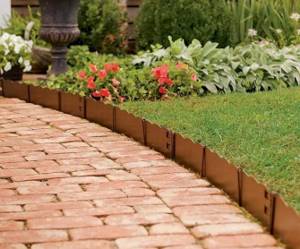
Border tape in the design of a paved path Source lestorg32.ru
- Resistance to mechanical loads . The fence remains intact even when the ground moves or the soil swells.
- Reuse . Most models are dismantled and can be reused.
The disadvantages of plastic garden accessories include the following features:
- Artificial origin . Plastic is the result of refining petroleum products; this explains its durability and inertness to external influences. Plastic products do not harm humans and plants, but must be disposed of at the end of their useful life. Recycling concerns fall on the shoulders of the site owner.
- Restrictions on Use . The strength of curbs is limited to certain limits; they are not intended for fencing a car area.
- Easy installation . This also automatically means simple dismantling. The owners returning after a long absence may discover that the decorative fence is missing.
Using border tape in landscape design Source seattlehelpers.org
Installation of plastic borders
Curbs of all types are installed according to a similar pattern:
- A line is drawn along the path along which the fence will go.
- The cord is stretched: it will allow you to monitor how evenly all the elements are located in height.
- A narrow ditch 8-10 cm deep is dug along the path.
- While the preparatory work on marking the area continues, you can warm the border in the sun: it will become softer and more pliable, and if it is a tape, it will be easier to cut it to size.
- The fence is carefully inserted into the groove and fixed using the anchors included in the kit, checking the evenness of the installation along the cord.
- If a sectional border is used, then all elements must be fastened together with a locking connection.
- The earth is poured back into the groove and carefully compacted, making sure that the fence does not deviate from the vertical.
Plastic borders are well suited for earthen, sandy and sawdust-strewn paths, as they prevent grass from growing and help the path maintain its shape.
Concrete curb
This type of curbs is used to complete the design of asphalt paths paved with paving slabs, as well as concrete, stone and paving stones. This is a rigid and reliable fence that can last for decades.
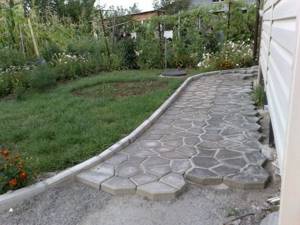
Concrete sides are best combined with paths made of paving slabs Source 709703.ru
Types and purpose of borders
The manufacturer of paving slabs plitkaekb.ru offers reinforced concrete curbs for various needs and requirements.
- Sidewalk – standard meter blocks 220 mm wide and 75 mm high. High strength and the simplest form allow such borders to be used very widely when arranging plots and local areas. They are convenient and easy to install.
- One-sided thin - due to its small dimensions (length of one block - 500 mm, width - 210 mm, height - 40 mm) allows you to design narrow paths, small parking lots, flower beds, etc. This type of border has only one side – the front side.
- Double-sided - allows you to make both sides of the paths façade. Its standard dimensions are: block length – 500 mm, width – 70 mm and height – 210 mm. It is usually used to delimit parallel paths, alleys, and for landscaping local areas.
All products are made from concrete using the vibration casting method. Such borders are particularly durable due to the use of a plasticizer in the mixture.
The main advantages and disadvantages of concrete curbs
Strengths of the curb:
- durability: can last half a century;
- strength, resistance to mechanical loads;
- easily tolerate temperature changes;
- undemanding to operating conditions and maintenance;
- look neat;
- resistance to water and chemicals;
- accessibility and prevalence: you can buy a concrete border for garden paths or make it yourself.
There are also negative qualities:
- heavy weight;
- thorough preparation of the land and skills in working with cement, stone, and tools are required;
- rustic appearance, limited selection of designs for ready-made products.
Design of vegetable borders for garden paths: tips in the photo
Published Jul 9, 2019
Modern country property owners and professional florists are constantly coming up with ways to decorate their garden plots that will help make it inimitable. One of the well-known techniques is replacing traditional borders of garden paths with spectacular plant compositions. Landscape designers offer many options for designing paths: these include neatly trimmed conifers, perennial shrubs, and picturesque flower beds.
Garden paths are necessary elements of landscape design, connecting all corners of the garden, dividing the site into functional zones, preserving well-groomed lawns, spectacular flower beds and vegetable beds from trampling. To prevent the area from looking too flat and monotonous, the perimeter of paths cutting through a smooth lawn is decorated with green spaces and bright flora.
In a garden of strict design, decorative conifers (juniper, boxwood, thuja) look great in the design of straight country sidewalks, the rich color of which complements and sets off the delicate greenery of the mowed lawn.
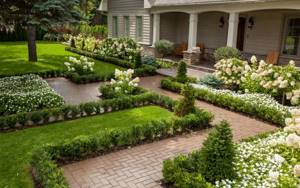
Exotic evergreen shrubs can be given a variety of shapes and are easy to prune.
Coniferous crops can be combined with green or flowering plantings. To make the composition look decorative, carefully select the palette and size of the plants. The border can be multi-tiered - tall bushes will become an excellent background for the low-growing edging of the path.
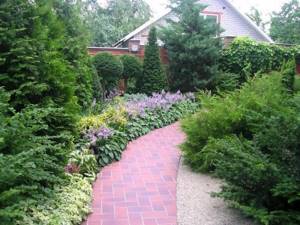
Perennial shrubs are also suitable for creating living fences: hosta, heuchera, barberry.
Flowering shrub plants, for example, spirea, hydrangea, and astilbe, look very picturesque in the design of borders.

To decorate the garden path with luxurious roses, low or creeping varieties are used.
To make the borders elegant from the first warm days, country paths can be decorated with spring primroses - tulips, daffodils, irises, hyacinths.
Recent Entries
How to clean a frying pan from carbon deposits in 10 minutes Don’t throw away yogurt cups: 3 cool craft ideas for kids Decorating for pennies: 6 ideas for crafts made from plastic spoons
Although perennial crops are often used to decorate paths, borders of flowers planted every season also look very picturesque. The choice of plants for compositions depends on the taste of the owners - it can be bright, unpretentious petunia, modest marigolds, spectacular coleus, or a colorful mixture of several species.
Beautiful mixborders can be obtained by combining perennials of different colors and textures. Asters, phloxes, and tenacious are very popular, among the varieties of which there are many ground cover border options.
An original solution is a fence of spicy flowers and herbs (mint, basil, lavender, thyme). Plants will fill the garden with a pleasant aroma and will be useful for brewing healthy tea after the summer season. And dry lavender is used in everyday life to fight moths.
Low-growing strawberry bushes can be planted not only in separate beds, but also along the garden path - this will make it more convenient to care for the fruit-bearing plant and harvest.
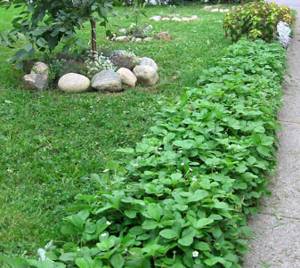
Garden paths surrounded by dry streams and rockeries look good. Their design should be in harmony with the overall design of the garden plot.
Creating a garden in a landscape style provides great opportunities for the creative efforts of designers and gardeners. You just need to take into account that only shade-loving varieties are planted under the spreading crowns of trees. Preference is given to unpretentious perennial crops.
Plants on the natural slope of a naturally designed garden will prevent the soil from sliding during heavy rainfall.

Paths can be decorated not only with flowers planted in open ground, but also with interesting container compositions.
Blooming and green fences of country paths are a useful and colorful detail of landscape design. A large selection of plants for decoration and bright color combinations will make the look of your garden unique and elegant.
- Author: Olga Zagainova
Rate this article:
- 5
- 4
- 3
- 2
- 1
(31 votes, average: 4.8 out of 5)
Share with your friends!
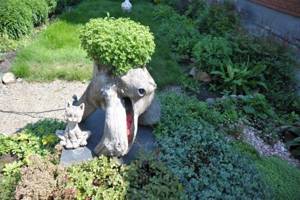
Design of garden rutarii: options for landscape compositions
Arrangement of paths at the dacha with your own hands: 20 ideas in the photo
How to make a concrete side on your site
There are 2 options for making a fence on your site. You can assemble it from ready-made blocks, make them yourself, or fill the border directly on site.
Working with blocks
The finished parts of the border have standard dimensions. Lay them edgewise or wide side.
The concrete block is very heavy, so thorough preparation of the ground is required. Lay it like this:
- Dig a trench a little wider than a block and about 20 cm deep.
- A layer of crushed stone is poured and compacted.
- Sand is poured on top, watered and compacted. It needs to fill all the cracks.
- Concrete is poured onto the prepared “cushion”, and blocks are immersed in it.
- The border is leveled using a level or a stretched rope, tapping with a rubber hammer.
- The remaining mortar is used to seal the joints.
The fence can be installed simultaneously with the creation of the path or after it is ready.
Self-production
If standard blocks are not the right size, you can make them yourself. To do this, you will need molds: you can buy ready-made plastic ones or assemble them yourself from wood or channel. If you need a colored curb, then add the desired color to the solution when mixing. The dosage depends on how intense the tone is required. You only need to buy paint suitable for such work. After the solution has hardened, the finished products are removed from the molds and installed in the same way as purchased ones.
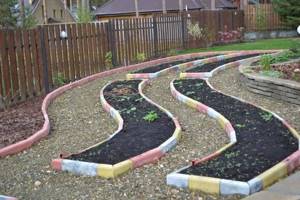
A multi-colored border enlivens the area and brings fresh notes Source sandstone.by
Another option is to pour concrete fencing into the formwork. A strip foundation is made in a similar way:
- Dig a trench where the formwork will be installed.
- The formwork is made of boards, plastic or steel and secured with pegs.
- Cement mortar is poured into the finished form and compacted to remove all air bubbles. Then the concrete will be strong.
- Then the surface is leveled.
- After the concrete has hardened, the formwork is removed and expansion joints are cut every 1-1.5 m.
- The final stage is filling with earth and compacting it.
A border filled using this method is not aesthetically pleasing and will require additional decoration. But it will be durable and reliable.
Forms for borders
The theater always starts with a hanger, so you will have to purchase a form for the border or make it yourself long before digging a trench for the monolith.
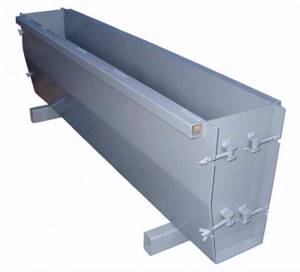
You can see the available and ready-made options in the photo of the decorative border. You can create a form like this:
- The cheapest option is to use sheets of plywood. If there are only sheets of chipboard in the utility room, it is advisable to wrap them with film, then the end result will be smooth and without unnecessary textures.
- You will also need long wooden beams.
- Screws for fastening the frame.
- Screwdriver or screwdriver.
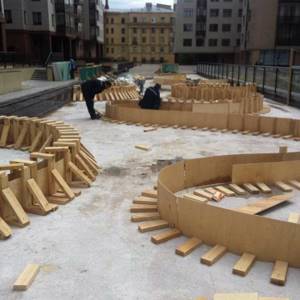
Blocks are usually made 1-1.5 meters. If you do more, the slab may burst under the weight.

For those who don’t want to bother with constructing blocks themselves, there is the opportunity to purchase plastic ones. They are quite stable and can be resold later.
To obtain decorative fences and borders, there are ready-made forms with additional elements. Most often you can find imitation brick or artificial stone on the counters.

We recommend reading:
- Making a mailbox with your own hands: tips and step-by-step descriptions of how and what to make a mailbox from (95 photos)
- How to install a garden swing: the best ideas and installation options in landscape design (110 photos + video)
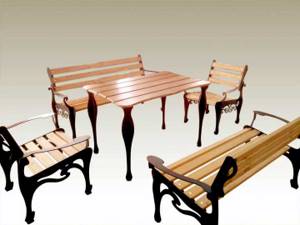
The best garden furniture: tips for choosing, the best sets and options for their placement (100 photos)
Metal border
Metal borders are among the most durable and strong. They are made of copper, aluminum or stainless steel and coated with a polymer coating that protects against corrosion. Metal products are produced in the form of ribbons or decorative grilles and rods. Their edges are often rounded.
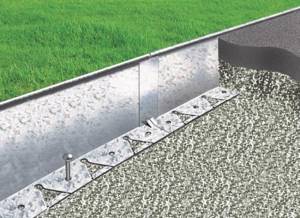
Laying a metal border strip Source acodrain.com.ua
The ribbons are practically invisible on the site: they should protrude from the ground no more than 2 cm, and deepen by at least 10 cm. Therefore, the total height of the border should be at least 12 cm.
Decorative grilles are used if they want to decorate an area in a single style, for example, so that the decorative elements of a fence and border for a garden path have something in common. Each owner determines the height of the protrusion independently.
Advantages and disadvantages
Metal products are popular because:
- have high strength;
- serve for decades;
- tolerate temperature changes well and are resistant to strong heat;
- keep the shape of the tracks well;
- ideally isolate paths from grass growth;
- optimal for bulk paths, for example, made of crushed stone;
- easy to install;
- can be used for winding paths.
The only downsides that can be noted are the high price of the fences, as well as the fact that the metal can react with some chemicals.
Installation
Installing metal borders does not require special skills. The tape is simply immersed in the ground to the desired depth. You can tap it with a hammer or mallet. There is no need to dig trenches for the tape. Another option is to secure it with special pegs.
Wooden borders
You can use wood to create a variety of fencing options for garden paths. You can purchase ready-made ones or make them yourself. It is not necessary to buy new lumber for the work; leftovers may be suitable. For example, if you recently built a house, there are likely to be saw cuts from timber or rounded logs. These “bubbles,” if trimmed and processed, can be placed on the side along the path near the house. They will look original. You can also use boards, pegs or rods. Wooden borders are suitable for paths sprinkled with tree bark or sawdust.
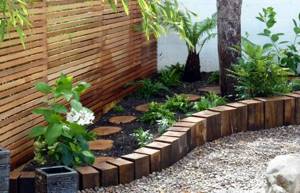
The fence can be made from small pieces of timber Source www.santabarbaradesignhouseandgardens.com
Advantages and disadvantages
Advantages of wooden borders:
- aesthetics: even with minimal effort you can make a beautiful fence for a path out of wood;
- environmentally friendly material;
- high strength.
There are also disadvantages here. Thus, wood, even treated, is significantly inferior in durability to metal and concrete, usually within 10 years. Installation is not simple: it is necessary to provide drainage and waterproofing. Yes, and assembling the fence will take time. Not all types of wooden edges are equally good at preventing grass from growing, for example, wicker fences look beautiful, but cannot prevent it from appearing on the path. They won't be able to hold the embankment either. Therefore, they must be combined with plastic or metal tapes.

A combination of sides made of different materials allows you to zone the area Source usdecorating.com
Manufacturing and installation of wooden fences
To make a beautiful border, you can use any lumber: boards, bars, saw cuts, etc. The good thing about wood is that it can be easily processed, burned, and can be painted and varnished. There are many options for making decorative borders: from simply laying boards along a path to a carved picket fence. One of the simplest and most aesthetic solutions is fencing made from saw cuts. Work begins with preparing the elements:
- All parts of future sides are aligned by size: length, width, height. They must be cleaned of bark and dirt.
- Treated with impregnations that protect against rotting. The solution is applied to the boards with a brush. It is better to soak the saw cuts by immersing them in an antiseptic for at least 23 lengths.
- Dry well.
- Dig a trench and pour sand into it. It is necessary to have a drainage system and waterproofing for the material to last a long time.
- The parts are placed on a sand cushion and driven into it. To prevent the wood from cracking, use a mallet rather than a metal hammer.
- The upper part of the cuts is painted or varnished: this way the wood will look better and last longer. The coating imparts decorative qualities and protects against weathering and rotting.
Borders made from scrap materials
Fences for paths can be made from scrap materials: plastic or glass bottles, car tires, vines, stones left over from the construction of bricks, slate or tiles, etc.
Bottle fences
Drink containers are one of the most accessible types of recyclable materials. They are quite resistant to water and chemicals, only impacts pose a serious danger to them. You can make a border for a garden path from glass or plastic bottles. The first option will be more durable.
Sand, small pebbles or crushed stone are poured into the bottles up to half. The neck is clogged. A cord is placed along the path. The height of the curb will be aligned with it, and the twine will also prevent you from deviating from the straight line. Dig a trench to the depth of half the bottle and fill it with cement mortar. The container is inserted neck down and aligned with the cord. Bottles can be placed straight or at a slight angle. Then the concrete is covered with earth. If desired, the resulting fence can be further decorated.

Bottles can make an original fence Source kakpostroit.su
Plastic bottles can be installed in a similar way. They can also be used as temporary fencing. Then the side is made according to a simpler scheme: they cut off the neck of the bottles and insert them into the ground. The soil must be compacted well so that the container holds. The top of the plastic can be painted. Or arrange bottles, alternating them by color.
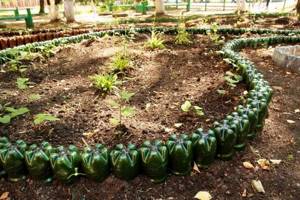
Plastic bottles have long become a popular building material Source lookathis.ru
Car tires
A curb from old rubber can be made in different ways:
- I bury the old wheels halfway into the ground. The soil around is well compacted. The tires are then painted.
- Strips of suitable width are cut from rubber and secured to bars dug into the ground. Sometimes such tapes are placed on cement mortar so that they stick better.
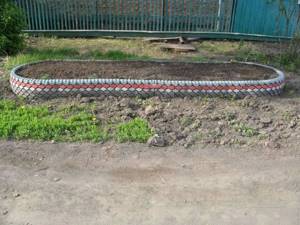
Tires have long been used to decorate garden plots Source i.mycdn.me
Brick remains
The brick left over from construction is an excellent material for fencing paths. It is strong, durable, environmentally friendly. In this case, the bricks can be placed in any way: vertically, horizontally, at an angle. You can simply dig it into the ground, but it’s safer to “plant” it on cement mortar. In this case, the technology resembles working with bottles: they dig a small trench, fill it with concrete and lay bricks. To make the side even in height, you need to tighten the cord.
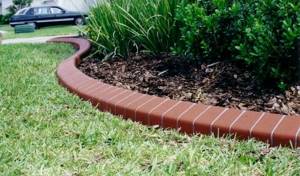
Brick as a fence looks very aesthetically pleasing Source remboo.ru
Borders for flower beds - 65 ideas for a summer house

I bring to your attention a selection of 65 ideas for decorating borders and fences for your country flower bed. There are a lot of options and you will probably choose the one that is most suitable for both the style and composition of your flower garden.
1) Border for flower beds made of hollow blocks

A very nice solution for a house flower bed; a plus is the ability to plant flowers in the cavity of the blocks themselves.
2) Ornament made of paving stones

An interesting and fresh solution is to lay paving stones directly on the lawn; you can also visually delimit the whole space into sectors. Separate tall grass from trimmed grass, for example if part of the lawn is allocated for a flower garden.
3) Budget idea for a plastic border
Modern options for borders for flower beds made of plastic sometimes look very presentable. For example, here is an option for a stone.
4) Borders of tiers on the lawn
The photo offers an interesting option for those who have a small slope on their site. By making such a transition, you will create an expressive accent on the lawn.
5) Idea with border tape

Flexible border tape can also be an excellent solution for those who want to quickly and beautifully equip the borders of their flower beds.
6) Gravel curb

A similar gravel border can be used to separate both the terrace and the flower bed. The idea is suitable for any dacha elements.
7) Pebble borders

If gravel or crushed stone has sharp corners, then pebbles rolled by rivers and seas look somehow kinder. If you plant succulents in it, the space between the flowerbed and the lawn will be even more beautiful.



Flowerbeds with tall plants can be separated by some kind of higher fencing, such as wooden fences.
9) Border made from tree cuts

A border made from tree cuts will also look original, and they can be integrated both horizontally and vertically.
10) Openwork metal borders

Openwork fences are sold in parts and are very easily inserted into the soil. Or they are mounted on a monolithic base.
11) Wicker border idea

If you have creative weaving skills, then here's an idea for a wattle fence - a natural border for a flower bed for several seasons.
12) Idea for a pattern on a flower bed
The pattern on the flower bed will visually divide the space between the plants and give the flower garden an accentuated color scheme.
13) Bottle borders
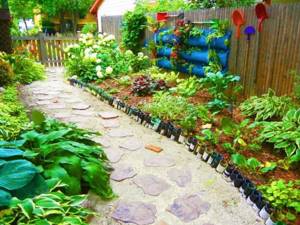
The bottles can be used as a border for a flower bed; in addition, they can be filled with sand.
14) Decorative pillars with lighting
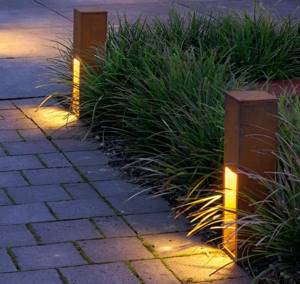
This is more of a night decoration of paths, but this installation can also be called a curb.
15) Grass borders
Ornamental grasses can also serve as a wonderful demarcation between a flower bed and a path or lawn.
16) Stone border idea
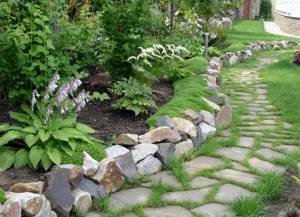
Similar borders are used in Japanese gardens - these are flat stones placed on edge. You can also use pebbles.
17) Log cuts
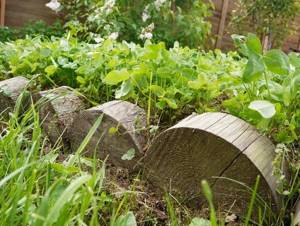
Logs left over from cutting old trees can also be used as a decorative border in your dacha. Both for flower beds and for visual boundaries of plots.
18) Raised flowerbed
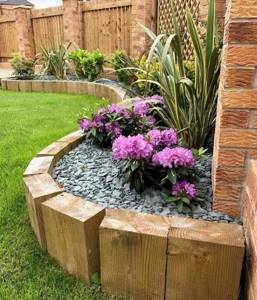
In some cases, a border can act as a wall for a raised flower bed.
19) Border made of metal pipes
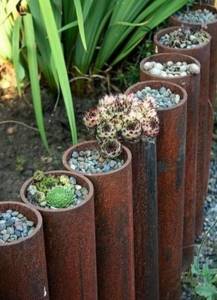
Metal pipe scraps can also serve as a beautiful decorative element in your garden, just don't forget to paint them!
20) Border for a flower bed made of tires
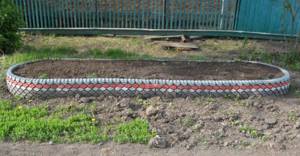
Old tires can become a beautiful element of landscape design - in the border of a street flower bed, but here it is important to observe moderation and expediency. In some cases, such aesthetics may be inappropriate.
21) Fences made of metal compositions
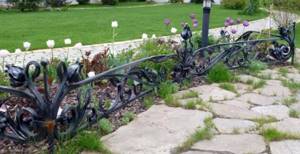
Sometimes you can find very attractive metal structures that can be used as borders.
22) Picket fence

And, of course, you can’t help but draw your attention to the traditional small fences made of wooden picket fences.
23) Borders for flower beds made of timber

In small areas, flower beds can be placed along the fence, along the perimeter, and the border itself can be made of timber.
24) Gabion border idea

To be honest, the idea of using gabions seems somewhat strange to me. But still, for the sake of completeness, I give this option.
25) Cement curbs

I know people who love cement, and they are very good at using it in garden design. Perhaps this idea will suit you too.
26) Patio border idea

I have also seen flower beds made from borders in the yard - this is a solution similar to the one in the photo. Any patio can be additionally decorated with a paving stone border. For contrast, choose a color that differs from the main tone of your seating area.
27) Decorative inserts

Since we are talking about the patio, it can be additionally decorated with small inserts of flower beds along the border.
28) Stone border

You can separate the paths from the lawn or from the flower bed by laying stones in cement.
29) Border made of ceramic pots

This is a fantasy idea; who, tell me, would use good pots in such a strange way? Nevertheless, since I have such an idea, I share it with you too.
30) The idea of a border between a pond and a lawn
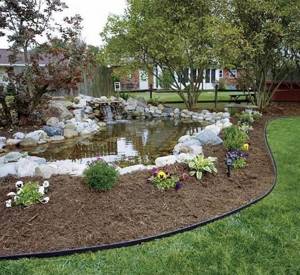
A decorative pond in the corner of the site can be expressively separated from the lawn by a border made of brick or paving stones.
31) Border made of sleepers or timber
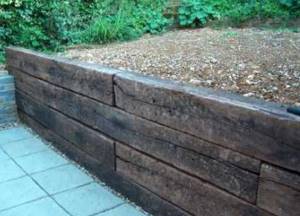
Old wooden sleepers or timber can be used as a border for fence flower beds.
32) Border made of wild stone pellets
An idea made from pellet stones can be a beautiful option for a border on large areas.
33) Another option for a border with gabions
I think that in this case it would be more beautiful and aesthetically pleasing to place the stone on the mortar than to use gabions. The mesh holding the stones seems unnecessary to me.
34) Posts with ropes
The idea of separating a flower bed from a lawn or path may be the same as in the photo. Only the columns should be made lower.
35) Border with LED strip
A popular idea in recent years is to illuminate the path with an LED strip, integrating the strip into the curb.
36) Boulder border
An original natural border can be a fence made of large boulders. In this case, the path is made of crushed stone or gravel.
37) Idea for a border with a stream
You can run a small stream along a flowerbed or path; the idea can be relevant even if you do not have a source of running water. You can loop the stream using a pump.
38) Shell border idea
If you often go to the sea and bring a lot of shells, which then just lie in bags, then I suggest you use them as decoration on borders.
39) Curb amphitheater
If you have a slope on your site, then this idea will allow you to create flower beds in the form of an amphitheater, using each tier as a separate level.
40) Separating a flower bed without a border
However, if you do not want to use any borders at all, then this idea illustrates this possibility. True, you will have to trim the border regularly.
41) Idea for a border in a small area
The wooden terrace along the contour is made of white pebbles with flower pots placed on it.
42) Box borders
In some cases, boxes with plants can also act as borders.
43) Border made of stone and tiles
Alternatively, you can use only ceramic tiles.
44) Border between the lawn and flower bed made of tiles
The base can be cement tape.
45) The idea of a gravel tree trunk circle
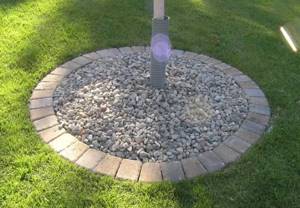
You can separate the tree from the lawn by filling it with gravel in the tree trunk circle.
46) Pebble border
Idea for a pebble border with a pond.
47) Border in the form of a pond
A controversial idea, especially if this “curb” is not illuminated...
48) Waterfall and stream idea
Along the contour of the site you can let a stream emanating from a waterfall.
49) Stone border between the lawn and the terrace
Another example of a border between a lawn and a terrace.
50) Border made of timber and brick
The combination of their timber and brick is a great idea for a border between a lawn and a flower bed.
51) The idea of a dry stream near the house
52) The idea of a border made of timber along the fence
53) Gabions from construction waste
Among European designers there is a certain craving for completely crazy ideas. I wonder if there are people who want to make such a border for themselves?
54) Border made of ceramic tubes
55) Border made of different-sized timber
56) Brick border on edge
Previously, such a border could be seen in every yard, but now this idea is one of the rarest.
57) Traditional brick border
58) Classic borders in regular European gardens
59) Wattle border
A wattle border can be used for both a flower bed and a tree trunk.
60) Curb made from car tires
Probably appropriate in front of the house, but not on the site. In this case, the tires should be painted with oil paint so that they do not emit toxic substances.
61) Border made from old plates
62) Border from a living stream flowing through the site
63) Idea for a border with original weaving
64) Combined border made of timber and saw cuts
65) Border for a flower bed from old boards
I recommend either painting the boards one color or several colors, alternating them with each other.
66) Border lattice of branches
I hope that today’s selection of ideas for your summer cottage was to your liking. Share border ideas with your friends on social networks, visit my website daily and get a lot of aesthetic pleasure!
Share link:
- Click here to share content on Facebook. (Opens in a new window)
- Click to share on Reddit (Opens in new window)
- Click to share on Pinterest (Opens in new window)
